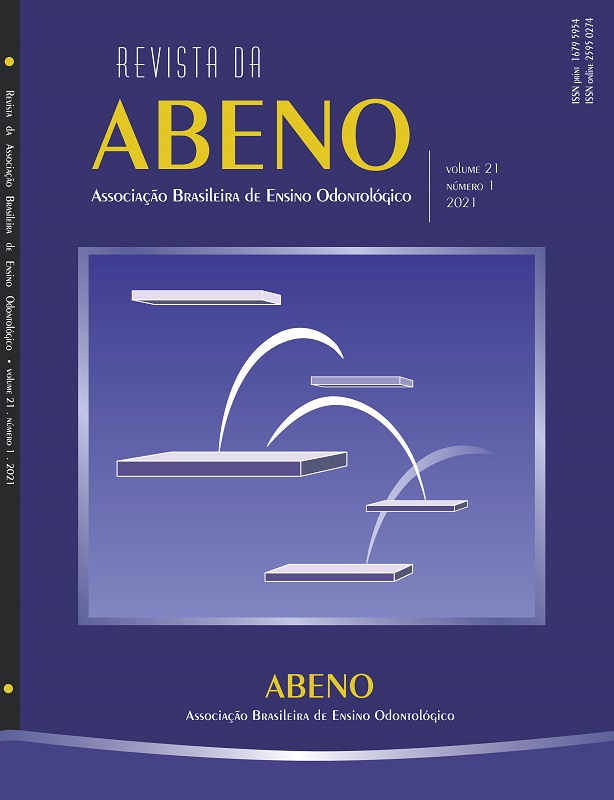Evaluation of the knowledge of dental students on light curing
DOI:
https://doi.org/10.30979/revabeno.v21i1.1065Keywords:
Dental Education, Dental, Light Curing, Composite Resins.Abstract
The clinical success of resin materials depends on adequate curing. Several light cured materials are frequently used in dental school clinics. This study aimed to assess the knowledge of students from the 10th period of Dentistry at Maurício de Nassau University Center, Recife/PE, about light curing, using a questionnaire. Data were tabulated and analyzed by descriptive statistics, Pearson chi-square test and Fisher exact test, at a significance level of 5% (p<0.05). The results show that 83.8% of students do not have a light curing unit, 72.9% do not know the device power, 56.2% do not know the ideal minimum power and only 8.5% know the name of the device that measures the irradiance/power. Also, 48.5% do not know the ideal wavelength for light curing of composite resin and 69.2% do not know the type of device they use (monowave or polywave). Regarding the light curing time, 60.8% stated they used 20 seconds in conventional composite resins and 38.5% used 40 seconds in bulk-fill composite resins. Although 84.6% stated that they use light curing units frequently, only 26.9% know the ideal distance from the tip to the restoration. Additionally, 51.5% reported performing cleaning and disinfection with 70GL alcohol and 45.4% use a plastic barrier. In this context, it can be concluded that the knowledge of students regarding light curing was unsatisfactory, requiring a more effective approach and evaluation so that the students may be aware of the clinical importance of this procedure and its consequences.
Downloads
References
(1) Marson FC, Mattos R, Sensi LG. Avaliação das condições de uso dos fotopolimerizadores. Rev Dent Online. 2010; 9(19):15-20.
(2) Ruggeberg FA, Giannini M, Arrais CAG, Price RBT. Light curing in dentistry and clinical implications: a literature review. Dent Mat. 2017; 3(suppl):64-91.
(3) Firoozmand LM, Araújo RM, Balducci I. Influência de fotopolimerizadores de luz halógena x LED azul na dureza de resina composta. Ciênc Odontol Bras. 2005; 8(1):67-74.
(4) Santana DP, Carvalho ALP, Pizani AMA, Sarceni CHC, Queiroz CS. Avaliação da microdureza em resinas compostas fotopolimerizadas com sistemas de luz halógena e diodo emissor de luz. Odontol Clin-Cient. 2010; 9(3): 239-42.
(5) Silva FJV, Silva EL, Januário MVS, Vasconcelos MG, Vasconcelos RG. Técnicas para reduzir os efeitos da contração de polimerização das resinas fotoativadas. Salusvita. 2017; 36(1):187-203.
(6) Beolchi RS, Forti W, Garófalo JC, Palo RM. O seu fotopolimerizador está preparado para novos materias? Rev Assoc Paul Cir Dent. 2013; 1(2):186-96.
(7) Marson FC, Oliveira P. Avaliação dos aparelhos fotopolimerizadores. Rev Uningá; 2008:(18):161-72.
(8) Shimokawa CA, Halow JE, Turbino ML, Price RB. Ability of four dental radiometers to measure the light output from nine curing lights. J Dent. 2016; 54:48-55.
(9) Watts DC, Kaiser C, O’Nell C, Price RBP. Reporting of light irradiation conditions in 300 laboratory studies of resin-composites. Dent Mat. 2019; 39:414-21.
(10) Price RBT. Light curing in dentistry. Dent Clin North Am. 2017; 61:751-78.
(11) Pereira AG, Raposo LHA, Teixeira DNR, Gonzaga RCQ, Cardoso IO, Soares CJ et al. Influence of battery level of a cordless LED unit on the properties on a nanofilled composites resin. Oper Dent. 2016; 41(4):409-16.
(12) Correia IB, Teixeira HM, Nascimento ABL, Costa SX, Galindo RM, Azevedo LM et al. Avaliação da intensidade de luz, da manutenção e do método de utilização dos fotopolimerizadores utilizados nos consultórios da cidade de Caruaru-PE. Rev Odontol UNESP. 2005; 34(3):113-8.
(13) Price RB, Ferracane JL, Shortall AC. Light-curing units: a review of what we need to know. J Dental Res. 2015; 94(9):1179-86.
(14) Beochi RS, Moura-Netto C, Palo RM, Torres CRG, Pelissier B. Changes in irradiance an energy density in relation to different curing distances. Braz Oral Res. 2015; 29(1):1-7.
(15) Price RB, Felix CA. Effect of delivering light in specific narrow bandwidths from 394 to 515 nm on the micro-hardness of resin composites. Dent Mater. 2009; 25(7):899- 908.
(16) Ikemura K, Ichizawa K, Jogetsu Y, Endo T. Synthesis of a novel camphorquinone derivative having acylphosphine oxide group, characterization by UV–VIS spectroscopy and evaluation of photopolymerization performance. Dent Mater J. 2010; 29 (2):122-31.
(17) Albuquerque PPAC, Moreira ADL, Moraes RR, Cavalcante LM, Schneider LFJ. Color stability, conversion, water sorption and solubility of dental composites formulated with different photoinitiator systems. J Dent. 2012; 67-72.
(18) Derchi G, Vano M, Ceseracciu L, Diaspro A, Salerno M. Stiffness effect of using polywave or monowave LED units for photo-curing different bulk fill composites. Dent Mat J. 2018; 37(5):709-16.
(19) Pereira SK, Pascotto RC, Carneiro FP. Avaliação dos aparelhos fotopolimerizadores utilizados em clínicas odontológicas. JBD J Bras Dent Estét. 2002 Dez; 1(4):1-8.
Downloads
Published
How to Cite
Issue
Section
License
Copyright (c) 2021 Revista da ABENO

This work is licensed under a Creative Commons Attribution-NonCommercial 4.0 International License.
Autores que publicam nesta revista concordam com os seguintes termos:
a) Autores mantém os direitos autorais e concedem à revista o direito de primeira publicação, com o trabalho simultaneamente licenciado sob a Licença Creative Commons Attribution que permite o compartilhamento do trabalho com reconhecimento da autoria e publicação inicial nesta revista.
b) Autores têm autorização para assumir contratos adicionais separadamente, para distribuição não-exclusiva da versão do trabalho publicada nesta revista (ex.: publicar em repositório institucional ou como capítulo de livro), com reconhecimento de autoria e publicação inicial nesta revista.
c) Autores têm permissão e são estimulados a publicar e distribuir seu trabalho online (ex.: em repositórios institucionais ou na sua página pessoal) a qualquer ponto antes ou durante o processo editorial, já que isso pode gerar alterações produtivas, bem como aumentar o impacto e a citação do trabalho publicado (Veja O Efeito do Acesso Livre).






